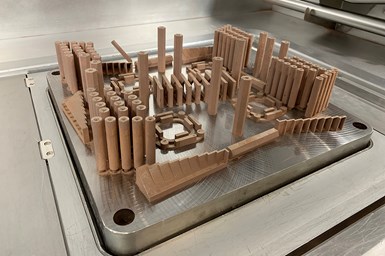Sintavia Develops Proprietary Copper Printing Technology
The printing technology is designed for use with GRCop-42, the preferred copper alloy used by NASA and private space flight companies for rocket thrust chamber assemblies
Share
Read Next

Sintavia’s technology unlocks the potential of printing GRCop-42 both cost-effectively and with excellent mechanical properties.
Sintavia has developed proprietary printing technology for GRCop-42, the preferred copper alloy used by NASA and private space flight companies for rocket thrust chamber assemblies. The technology is a combination of a proprietary parameter set and postprocessing heat treatment that could enable a new generation of flight and launch components.
The technology was developed on an EOS GmbH M400-4 printer, and results in GRCop-42 components with a minimum density of 99.94%, minimum tensile strength of 28.3 ksi, minimum ultimate yield strength of 52.7 ksi, and minimum elongation of 32.4%. Importantly, the technology avoids the use of a hot isostatic press in postprocessing steps, thereby reducing the time, complexity and cost of production, the company says.
This technology is said to unlock the potential of printing GRCop-42 both cost-effectively and with excellent mechanical properties. According to the company, GRCop-42 has been a difficult metal for additive manufacturing and this new material parameter and furnacing specification should enable full alloy adoption for AM applications within the aerospace, defense and space industry.
Sintavia is also currently developing proprietary standards for other materials, including refractory alloys, for use across the aerospace, defense and space industry.
Related Content
-
This Drone Bird with 3D Printed Parts Mimics a Peregrine Falcon: The Cool Parts Show #66
The Drone Bird Company has developed aircraft that mimic birds of prey to scare off problem birds. The drones feature 3D printed fuselages made by Parts on Demand from ALM materials.
-
6 Reasons Space Exploration Will Need Additive Manufacturing
There are at least half a dozen ways 3D printing will contribute to space travel, research and habitation — and in some cases it already is. Insights from seminar focused on manufacturing challenges for the space sector.
-
Why AM Leads to Internal Production for Collins Aerospace (Includes Video)
A new Charlotte-area center will provide additive manufacturing expertise and production capacity for Collins business units based across the country, allowing the company to guard proprietary design and process details that are often part of AM.







.png;maxWidth=300;quality=90)



